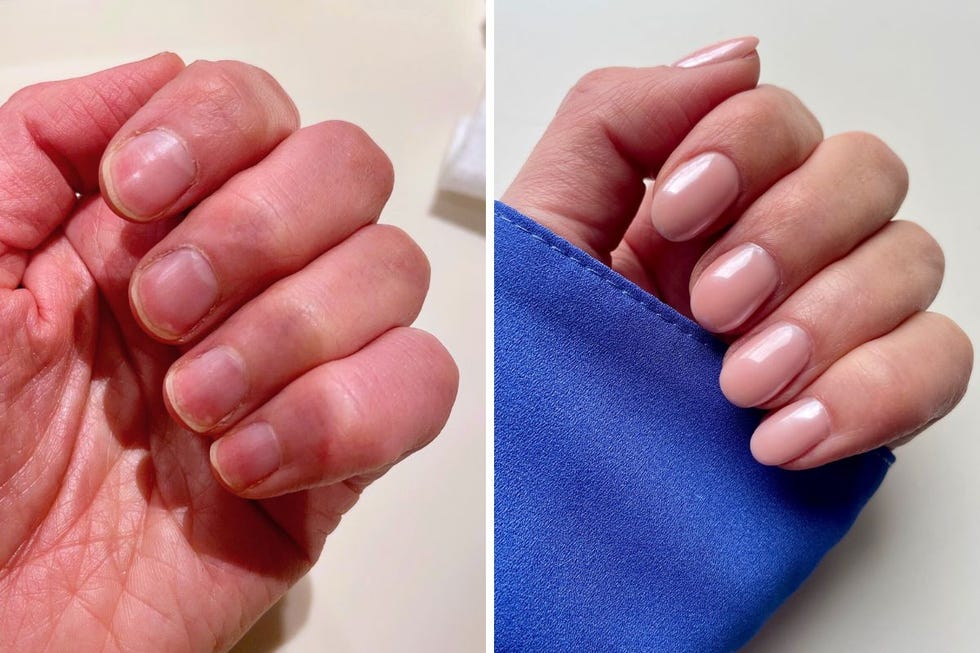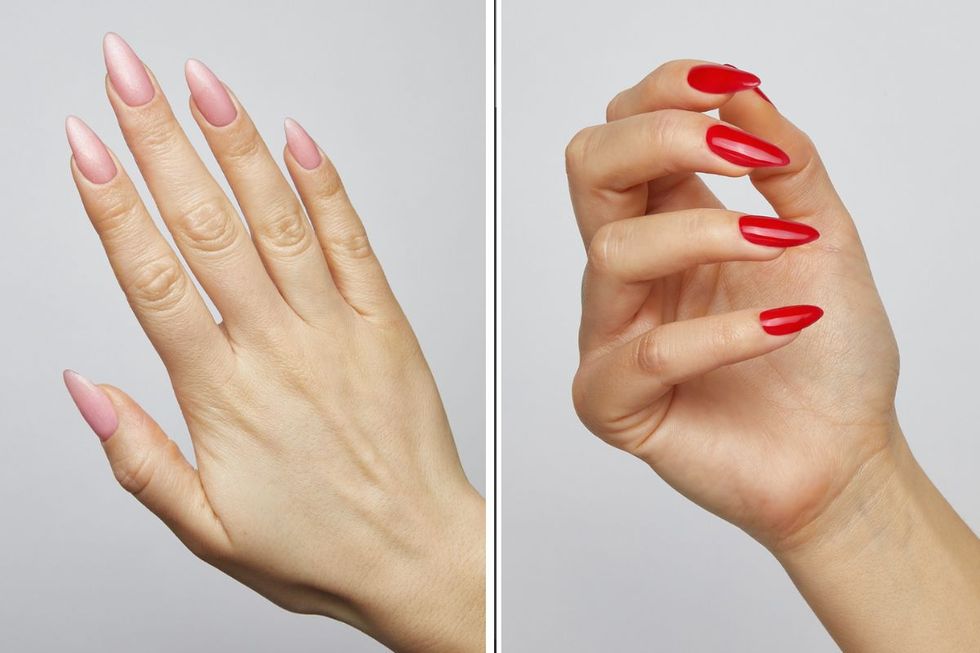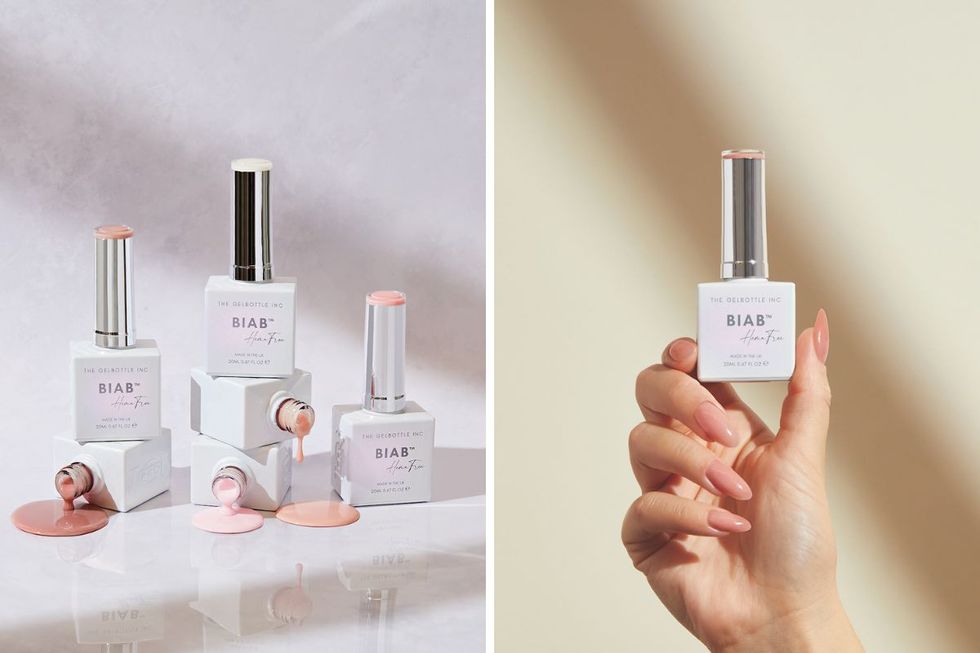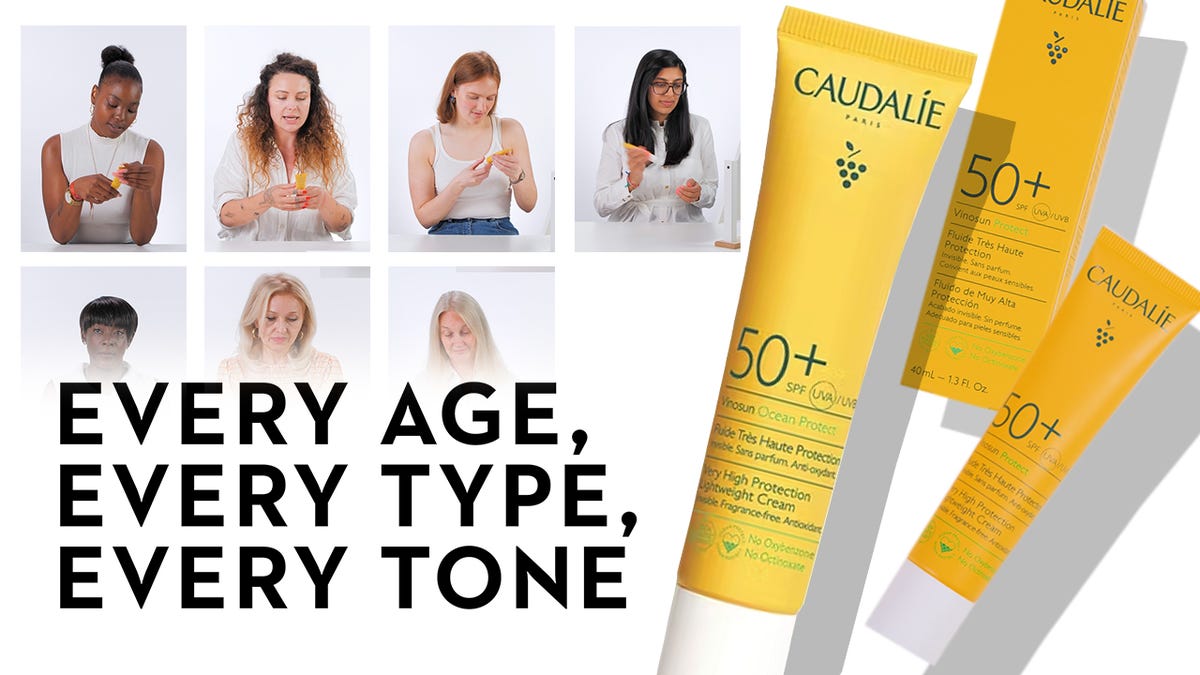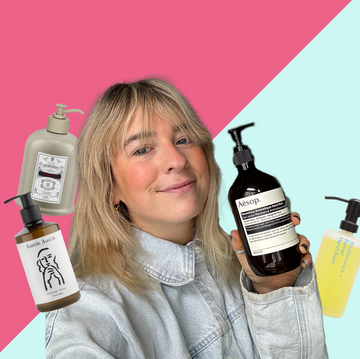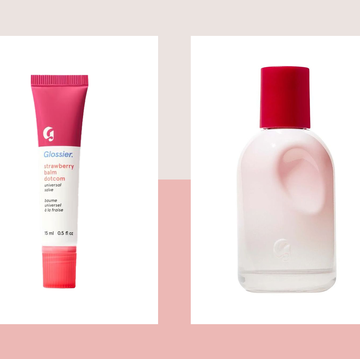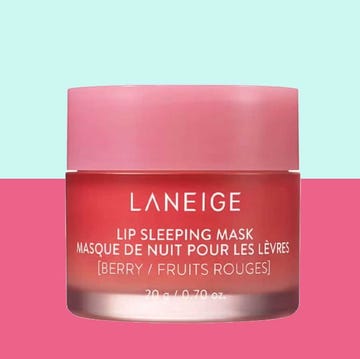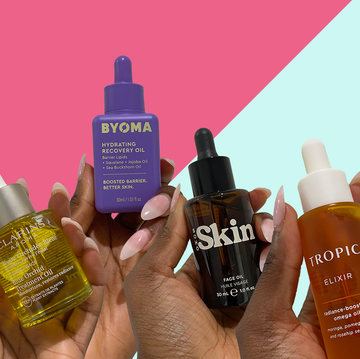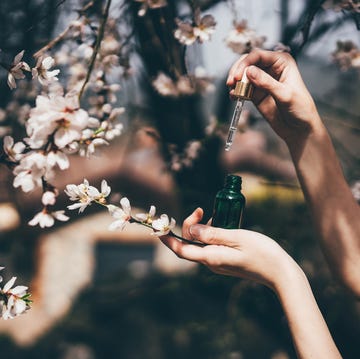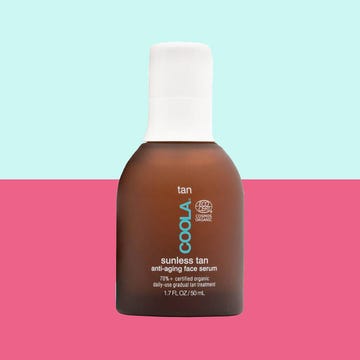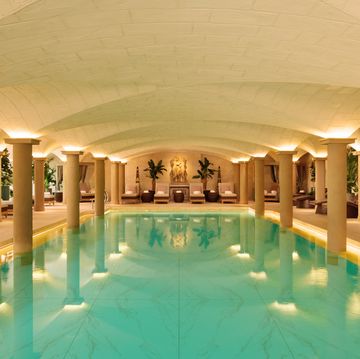A glossy, fresh-out-of the-salon manicure is one of life’s small joys. But a manicure that stays chip-proof for three weeks, and allows even the weakest, stubbiest nails to grow long and strong? That’s a total game-changer especially if, like me, you're cursed with bendy, ragged nails that no regular polish can ever prettify.
This perfect, prang-proof manicure may sound too good to be true, but that's precisely what's promised by BIAB, aka Builder In A Bottle. A salon service created to outlast a traditional gel manicure, BIAB is also designed to enable your natural nails to grow effortlessly. For those who could previously only get long nails with acrylic extensions, it’s revolutionary.
I didn’t quite believe it before I tried it, but speaking as a beauty director with two decades of experience, I can vouch for BIAB’s bullet-proof qualities. To my astonishment, BIAB has taken my paper-thin nails on a journey of growth in a way that no other manicure or strengthening treatment ever has.
You may be wondering why I didn’t just get a traditional gel manicure which also promises long-lasting, chip-free results. The simple truth is, gels never lasted on my flimsy nails, as gel polish is relatively thin and has very little flex. While gels looked great at first, they’d inevitably crack and chip within a week, fatally weakened by the bendy canvas they were painted upon.
BIAB, on the other hand, lends my nails the resilience that nature never did. Three weeks after my first session at Townhouse salons, I had the longest nails of my life, it's been effortless to keep them that way. (They would stiletto-shaped talons if I didn't file them down whenever they started slowing down my typing!)
I get them redone every three weeks or so, but only because the BIAB polish has grown out at the base, not because the tips have chipped. It's something I always make time for, because I love the way they (literally) make me look polished.
So what do you need to know about BIAB, and is it worth making the switch from a traditional gel polish? Are there any downsides to consider? And what are the best BIAB trends to note for 2025? Here’s the lowdown on this year’s most-wanted manicure.
What are BIAB nails?
Builder In A Bottle, or BIAB, is a salon-only product which gives natural nails a tough, snap-resistant coating, also known as an overlay. The original shades were mainly neutral but the offering is expanding fast – more on that below. “It was really important to us that we had tones to suit all skin tones,” says Giorgia Cappella, education manager at The Gel Bottle, which makes BIAB.
The overlay itself can be worn just as it is or be enhanced with nail art or a coat of any gel polish colour painted on top. BIAB certainly isn’t the only ‘builder’ product on the market, but it’s the best known and has been used by celebrities including Kim Kardashian, Kendall Jenner and Lily Allen.
How is BIAB different to gel nails?
BIAB is a different formula to traditional gel polish, which adds a harder protective layer to your natural nail compared to gel, says Giorgia. ‘A BIAB nail manicure allows you to grow your natural nails far longer than you would ever achieve with a regular gel nail polish treatment. It’s revolutionary, especially if you have weak nails and have always struggled to grow them.’
How are BIAB nails applied?
If you’ve ever had a gel manicure, BIAB isn’t entirely dissimilar. The product is applied directly to the natural nail, but because it’s a thicker consistency, the technician uses a tiny brush to shape it into a neat overlay across the nail.
Getting a smooth, thin layer is the key to a great BIAB manicure, but it does involve more skill than painting on a gel polish (and like most beauty treatments, it’s only as good as the practitioner). Once the overlay has been added, your nails are then cured, one by one, under an LED lamp.
How is BIAB used?
It’s pretty versatile. The simplest option is to wear BIAB on its own as a shiny, strong neutral nail shade. ‘The minimalist look is always popular,’ says Juanita Huber-Millet, founder and creative director at Townhouse. ‘Simple BIAB colours such as blush pinks, nudes and soft pastels are a lovely way to enhance the natural beauty of the nails.’ They make the perfect base shade for a classic French manicure.
A popular add-on is a chrome finish, which involves buffing a pretty, pearly pigment over the BIAB base shade. One trending look, which I'm currently wearing, is the 'Iced French' mani which adds a chrome topcoat over a regular French polish.
If you prefer to slip out of neutral gear, BIAB can be used as a base layer for nail art, tips or any gel colour you might fancy as your ‘main’ colour. ‘It’s often used as a base layer under a normal gel polish to give your mani that extra boost of strength while keeping your favourite colour on top,’ says Juanita. ‘It’s perfect for just before a holiday because you know you’ll have perfect, chip-free nails the whole time.’
How long does BIAB last?
‘BIAB tends to last around three to four weeks depending on your nail growth – it’s likely you will see your natural nail growing out long before the BIAB itself comes off,’ says Juanita. If you pick a natural shade, the growing out line isn’t as obvious as it is with a darker polish.
Should I swap from gel nails to BIAB?
If it ain’t broke, don’t fix it. BIAB is more expensive and takes longer to do – over an hour (more if you want to add on nail art), and costs from £60-plus a time. So if gel nails last well for you, it may not be worth swapping. However for somebody like me, who never even got a week’s wear from gels without chipping, BIAB is 100% worth the time and money.
What are the BIAB trends I should know about?
For summer 2025, Townhouse has a limited edition Ocean Alchemy lookbook, which dives into the wider trend for shimmery chrome textures that mimic look of sunlight glittering on the ocean. The water theme goes deeper with mermaid-inspired nail art details, such as sculptural shell patterns and deep-sea pearls. The lilac, pearl-studded Siren’s Charm design suits all nail lengths.
There’s also an aquatic take on the ever-popular French mani, which sees white tips swapped for gleamy opal, and accentuated with a slim band of gold. Moonlight Mirage looks truly opulent on longer nails but, as with all the designs, it can be adapted to all nail shapes and lengths.
Over at Paint London, the buzz over all things espresso continues – here it’s being served as a chic modern French with coffee-coloured micro-tips.
Are there any new innovations in BIAB?
You bet! The Gel Bottle recently announced 10 new shades of BIAB, meaning you can get a wider range of finished looks without needing a separate shade painted over the top. Fans of a chrome-like finish will appreciate the shimmery pink Sugar shade while anyone who's with a passion for a chic, classic red will be booking in for Love.
Do I need to remove BIAB every time or can I just get infills?
The jury is out on this one. ‘When it comes to BIAB nails, we always recommend a fresh treatment,’ says Juanita. ‘Continuous infilling without proper removal can actually lead to nail damage.’
However, Giorgia says: ‘You can consistently infill BIAB as long as the natural nail health is checked regularly. Removals are only necessary if you need to change the base BIAB colour or if there is lifting from the free edge caused by dehydrated nails.’ All nail technicians have a slightly different method for most things, and BIAB is no exception.
Can BIAB harm my natural nail?
Yes, if you pick it off or if you don’t check the nail health at each appointment. Whether you have a full removal or infill, the natural nail needs to be looked at properly.
‘During an infill, around 60% of the product will be removed leaving a sheer layer over the natural nail,’ says Giorgia. ‘Any issues may be visible at that point. You would be looking for changes to the colour of the nail that could indicate a pseudomonas, where water has become trapped between lifted product and the nail.’
For what it’s worth, I’ve worn BIABs pretty much consistently for well over a year, and never had any issues.
I’ve got a HEMA allergy, can I use BIAB?
Like most gel formulas, the original BIAB uses HEMA (hydroxyethyl methacrylate) as its curing active. ‘It creates that hard, shiny, long-lasting surface which everyone loves,’ explains Ifra Siddique, The Gel Bottle’s regulatory compliance director. ‘But because it's so widely used, it can potentially be an allergen. So like many brands, BIAB has now introduced a HEMA-free alternative.’
It comes in six shades, matched as closely as possible to BIAB’s most popular colours, and lasts nearly as well. ‘With normal BIAB we say you get 3-4 weeks wear,’ says Ifra. ‘With HEMA-free, we've 100% of user trials getting three weeks wear. So it’s as close as it can be, but there’s no need to switch unless you’ve had an issue with HEMA.’
Why do my nails feel hot during a BIAB treatment?
The ‘BIAB burn’ is something that’s regularly experienced during a manicure, but isn’t often understood properly by clients. The first time I ever had BIABs, I remember feeling my nails heat up and trying to tough it out. That’s a mistake.
If you feel heat, take your hand out of the lamp instantly, as heat spikes can harm the nail bed, especially if they happen repeatedly. The heat will vanish very quickly when you take your hand out of the lamp, but the sooner you remove the source of the problem, the better.
Heat spikes occur when the BIAB gel ‘cures’ under the UV lamp and gets hot due to the chemical process of polymerisation. ‘When using thicker consistency products such as builder gels, the more product used, the more likely you are to feel a heat spike as the UV tries to work double to kickstart the polymerisation [curing] process,’ says Giorgia. ‘The best way to minimise heat spikes is to follow the exact application method each brand outlines in their application guides.’
However, this doesn't always solve the problem. ‘Heat spikes are common for those with thinner nail beds, and even when products are used correctly and cured correctly may still be felt,’ says Giorgia. ‘The best thing to do is to remove the hands immediately if any pain is felt until it has passed and start the curing process again.’
Heat spikes aren’t inevitable, though. I generally experience them less now, presumably because my natural nails have become stronger and thicker on my BIAB journey. To be on the safe side, I often ask for my nails to be cured at a lower temperature and this solves the issue. It takes a little longer, but I think it’s worth it.
Ifra agrees that turning down the power is the right thing to do: ‘If you do naturally suffer from a heat spike, I'd always recommend having your nails done on a lower heat mode setting because that will lower the intensity of the lamp and allow the chemical reaction to happen more slowly, over a longer period of time.’

